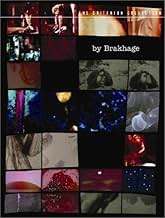Window Water Baby Moving
- 1959
- 13min
CALIFICACIÓN DE IMDb
7.5/10
2.5 k
TU CALIFICACIÓN
Agrega una trama en tu idiomaStan Brakhage films the birth of his first child, Myrrena.Stan Brakhage films the birth of his first child, Myrrena.Stan Brakhage films the birth of his first child, Myrrena.
- Dirección
- Elenco
Stan Brakhage
- Self
- (sin créditos)
Myrrena Schwegmann
- Self (baby being born)
- (sin créditos)
Jane Wodening
- Self
- (sin créditos)
Opiniones destacadas
10quin1974
I saw this short a few days ago at the Rotterdam Film Course for the International Rotterdam Film Festival and it blew me away. I had read some information about this short and wasn't that impressed, after all there are loads of programmes nowadays on TV that handle this subject as entertainment fodder.
What I did not know up front was the fact that Stan Brakhage never uses sound. That's probably where the power lies. The pictures were so incredibly strong and vibrant because of lighting, color and the sheer graphic visions Brakhage presents to the viewers that sound would have been distracting to say the least.
The pictures are not for the easily spooked persons or women who are thinking about having a baby. This is a straightforward account of child birth with all the gore, blood and beauty that accompanies it. It opened my eyes, 'cause I had never seen anything like it before in my life, and it is after all the most natural happening in the world.
After 13 minutes you will be left breathless.
10/10
What I did not know up front was the fact that Stan Brakhage never uses sound. That's probably where the power lies. The pictures were so incredibly strong and vibrant because of lighting, color and the sheer graphic visions Brakhage presents to the viewers that sound would have been distracting to say the least.
The pictures are not for the easily spooked persons or women who are thinking about having a baby. This is a straightforward account of child birth with all the gore, blood and beauty that accompanies it. It opened my eyes, 'cause I had never seen anything like it before in my life, and it is after all the most natural happening in the world.
After 13 minutes you will be left breathless.
10/10
An amazing avant-garde short of the birth of Brakhage's first child. This film is both graphic and beautiful while effecting each viewer a little differently. The colors in the film are especially striking. (Warning this film is not for the queazy).
While many women cringe at the thought of child birth and would never want to go through it, other women love children and are more than delighted to deliver a baby. I am a male, so I don't really have a true opinion, but I would really like to have a child someday. This film is essentially the birth of experimental filmmaker Stan Brakhage's first child. We witness his daughter being born without the sugarcoating or hiding the act. We see the birth in all of its glory. Many viewers will be nauseated with the sight, but others will be honored. This film is amazing because we see life actually being given and it is amazing. The human body is very complex, and the birthing process doesn't hide this fact. This is a film that people will watch for the ending. The ending makes the whole process worth it as the child turns out beautiful and We as viewers are treated to a loving sight of the child living and very healthy looking. This is the sweet side of Stan Brakhage. Usually his films involve the viewers in the difficulty of trying to figure out what he is trying to say, but this film is almost like a reward to the viewer. Children are beautiful and it is strange to realize that in twenty years, they will be running the country.
(I watched this film as part of the DVD short film collection of Stan Brakhage entitled, BY BRAKHAGE: AN ANTHOLOGY.)
(I watched this film as part of the DVD short film collection of Stan Brakhage entitled, BY BRAKHAGE: AN ANTHOLOGY.)
"Window Water Baby Moving" is possibly influential experimental filmmaker Stan Brakhage's most well-known film. In this masterpiece, he simply documents the birth of his first child. And it is possibly the greatest film he's ever made.
To be fair, I haven't seen Brakhage's "Dog Star Man", which also looks like a masterwork, but whether or not it is truly his best film, it is still a beautiful film.
Stan Brakhage uses his normal fast paced, experimental editing that has been used in his other documentary works (ex. "The Act of Seeing with One's Own Eyes"), as well as some very artistic, and highly experimental, camera-work. Brakhage's documentary films aren't just simple home movies, but great works of art, just look at the film! Every shot is an artistic masterpiece, and it is a truly great document of life and love.
Although the film uses highly graphic imagery to tell it's story, it is really a sweet document. Yes, the birth is shown in EXTREME detail, but, at the end, you see how loving these new parents are. The mother (Jane Brakhage) holds her newborn in her arms, and the father (Stan Brakhage) looks greatly excited and happy, he's hoping up and down, with a great smile on his face.
Stan Brakhage has proved himself, in my opinion, to not only be one of the great experimental filmmakers, but of of the great documentary filmmakers, as well.
To be fair, I haven't seen Brakhage's "Dog Star Man", which also looks like a masterwork, but whether or not it is truly his best film, it is still a beautiful film.
Stan Brakhage uses his normal fast paced, experimental editing that has been used in his other documentary works (ex. "The Act of Seeing with One's Own Eyes"), as well as some very artistic, and highly experimental, camera-work. Brakhage's documentary films aren't just simple home movies, but great works of art, just look at the film! Every shot is an artistic masterpiece, and it is a truly great document of life and love.
Although the film uses highly graphic imagery to tell it's story, it is really a sweet document. Yes, the birth is shown in EXTREME detail, but, at the end, you see how loving these new parents are. The mother (Jane Brakhage) holds her newborn in her arms, and the father (Stan Brakhage) looks greatly excited and happy, he's hoping up and down, with a great smile on his face.
Stan Brakhage has proved himself, in my opinion, to not only be one of the great experimental filmmakers, but of of the great documentary filmmakers, as well.
Quite a few years ago, I attended a secondary school excursion to the Melbourne Museum, where we focused primarily upon the science of the human body. As part of the tour, we also attended a screening for the IMAX film 'The Human Body (2001),' which used some nifty film-making techniques to demonstrate the workings of our organs, bones and muscles. The documentary even delved into the subject of reproduction, though I couldn't help noticing that the newly-born infant emerged in an peculiar state of utter cleanliness. Avant-garde Stan Brakhage apparently had no such inclinations towards prudishness. Perhaps his most notorious film, 'Window Water Baby Moving (1959)' {filmed in November 1958} documents in unflinching detail the birth of his first-born daughter, Myrrena Brakhage. Unlike the bewildering 'Mothlight (1963),' this is a Brakhage film that one doesn't need to decipher; the editing and images tell the entire story, not just of a human birth, but of the tender emotional bond between husband and wife, parent and child, and the all-seeing lens of the movie camera.
As a warning to potential viewers, 'Window Water Baby Moving (1959)' doesn't recoil from capturing the most intimate (and explicit) moments of the baby's delivery. Events that would ordinarily be glossed over in other films, such as the cutting of the umbilical cord, or the ejection of the placenta (which looks just as painful as getting the baby out), are documented in detail, over a 13-minute running time that feels substantially longer. Being a student of biology myself, I felt confident that I could manage well enough, though the truth is that I'm a complete prude. In fact, I probably should have filmed myself watching the film, because my facial expressions must have betrayed something akin to revulsion on at least one occasion. However, as soon as that tiny head emerged from the necessary orifice, I began to understand this "miracle of birth" that people talk about so frequently. Even this term, however, is a misnomer, given that there's absolutely nothing miraculous about reproduction in fact, it's perhaps the most natural phenomenon of all.
Brakhage's film surprised me in that I had expected a straightforward, literal documentation of the childbirth process, filmed in that continuous hand-held manner that characterises most modern home movies. However, his use of editing really breathes emotion into every scene. Even throughout the most crucial moments of the delivery, Brakhage cuts to shots of his wife, Jane, sharing an affectionate smile with the camera (behind which stands her husband, of course), or the couple's tightly-clasped hands, the husband offering his love and support during a time when the male was typically ejected from the room. 'Window Water Baby Moving' is a movingly personal ode to the immortal bond of family, and to cinema's ability to capture and bottle these emotions as best as it can. Brakhage obviously found this documentary excursion to be a worthwhile endeavour, because he repeated the effort several years later with 'Thigh Line Lyre Triangular (1961),' to record the birth of one of Myrrena's siblings. Not for the faint-hearted, but an unmissable avant-garde experience.
As a warning to potential viewers, 'Window Water Baby Moving (1959)' doesn't recoil from capturing the most intimate (and explicit) moments of the baby's delivery. Events that would ordinarily be glossed over in other films, such as the cutting of the umbilical cord, or the ejection of the placenta (which looks just as painful as getting the baby out), are documented in detail, over a 13-minute running time that feels substantially longer. Being a student of biology myself, I felt confident that I could manage well enough, though the truth is that I'm a complete prude. In fact, I probably should have filmed myself watching the film, because my facial expressions must have betrayed something akin to revulsion on at least one occasion. However, as soon as that tiny head emerged from the necessary orifice, I began to understand this "miracle of birth" that people talk about so frequently. Even this term, however, is a misnomer, given that there's absolutely nothing miraculous about reproduction in fact, it's perhaps the most natural phenomenon of all.
Brakhage's film surprised me in that I had expected a straightforward, literal documentation of the childbirth process, filmed in that continuous hand-held manner that characterises most modern home movies. However, his use of editing really breathes emotion into every scene. Even throughout the most crucial moments of the delivery, Brakhage cuts to shots of his wife, Jane, sharing an affectionate smile with the camera (behind which stands her husband, of course), or the couple's tightly-clasped hands, the husband offering his love and support during a time when the male was typically ejected from the room. 'Window Water Baby Moving' is a movingly personal ode to the immortal bond of family, and to cinema's ability to capture and bottle these emotions as best as it can. Brakhage obviously found this documentary excursion to be a worthwhile endeavour, because he repeated the effort several years later with 'Thigh Line Lyre Triangular (1961),' to record the birth of one of Myrrena's siblings. Not for the faint-hearted, but an unmissable avant-garde experience.
¿Sabías que…?
- TriviaIn the early 80's, Brakhage screened 'Window Water Baby Moving' to Andrei Tarkovsky who wasn't impressed with the film. Brakhage said in an interview: "The first film was Window Water Baby Moving. First of all I got nervous because Olga, who is teetering over me on the bureau, begins to sway. I've seen people faint at that film and I don't know, maybe she's never seen childbirth before. And then I see Tarkovsky's wife averting her face from the screen at times as you get to see some of the more explicit details of childbirth. ... Tarkovsky starts talking in rapid Russian, with Zanussi answering him, and whatever he's saying it's obviously angry. Finally, after a lot of these exchanges, Jane had the presence of mind to say, "What's going on? What's he saying?" So Zanussi starts translating and he says, "Well..." and we all wait, "Well... he says," and we wait some more, "he says that Art must have a mystery to it and this is too scientific to be Art.""
- ConexionesEdited into Alt-J: Pleader (2017)
Selecciones populares
Inicia sesión para calificar y agrega a la lista de videos para obtener recomendaciones personalizadas
Detalles
- Fecha de lanzamiento
- País de origen
- También se conoce como
- Window, Water, Baby, Moving
- Ver más créditos de la compañía en IMDbPro
Contribuir a esta página
Sugiere una edición o agrega el contenido que falta
















